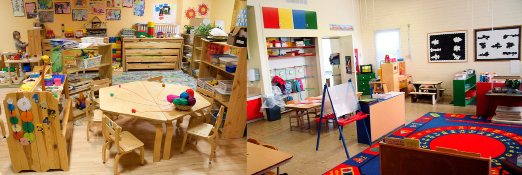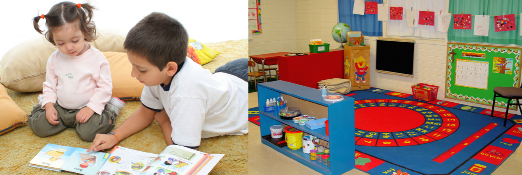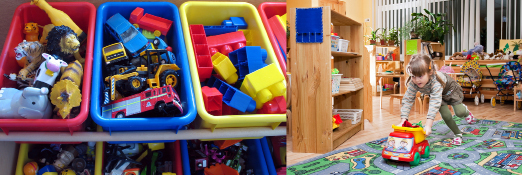Inquiry 1
1. Inquiry 1
Session 4: Guiding Children’s Behaviour
Inquiry 1: Child Care Practices and Children’s Behaviour

© MDmedia/iStockphoto
Behaviours of Concern
A child or a group of children’s behaviour is a concern when
- the safety of another child or adult is at risk
- the behaviour is aggressive toward another child or adult
- materials (e.g., toys, equipment, and so on) are being destroyed
Child care providers can only respond to behaviours of concern through guidance and redirection. Punishment, ridicule, humiliation, threats, and so on are not allowed at any time.
|
Guidance versus Punishment |
|
|
Children are guided when
|
Children are punished when
|
|
Children who are guided
|
Children who are punished
|
Factors Influencing Children’s Behaviour
intervention: techniques child care providers apply to help a child learn a more appropriate behaviour when a situation arises
Understanding the factors that affect children’s behaviour will help you guide children’s behaviour and prevent problems. Understanding will also help you practise appropriate intervention when problems do arise.
Child care providers choose a suitable intervention for the child and the situation. For example, providers might use redirection (directing toward a logical consequence) or they might help a child learn to problem solve.
The following three factors have a major impact on children’s behaviour:
- the interaction style of the child care provider
- the physical environment
- the program (activities and transitions)
Interaction Style of the Child Care Provider
Consider the following causes and effects:
- Child care providers who are warm and caring, and who value children as individuals, will encourage cooperative behaviour.
- Child care providers who treat children with care and respect and know each child—what the child enjoys, is frightened by, is frustrated by—will be much better able to prevent misbehaviours from occurring.
- Child care providers who have a clear sense of what is acceptable behaviour and what is not will pass these messages to the children.
- Child care providers who model the behaviour they expect from the children will be more effective than providers who do not.
- Child care providers who do not get angry when a child says something disrespectful or hurtful, but who react as caring adults whose job it is to teach the child appropriate behaviour, will be more successful at guiding the child’s behaviour.
- Child care providers who understand child development and set reasonable expectations will be more successful in preventing misbehaviour. For example, young children have a hard time waiting or sitting still; expecting them to do so is asking for problems.
- Child care providers who engage active listening strategies and who support children to express their feelings in words help reduce aggressive behaviour. (Remember, active listening involves responding to another person in a way that communicates that the message is being heard and understood.)
- Child care providers who always try to protect the children’s rights make children feel assured that they will be protected and help children learn about fairness.
Remember to do the following:
- Congratulate children on good behaviour and recognize their efforts.
- Set reasonable, child-specific, and age-appropriate limits and expectations.
- Match consequences to the age and developmental level of the child.
- Model problem solving.
- Every day, show the children that you care about and appreciate them.
The Physical Environment

Left: © dainis/shutterstock, Right: © Neo Edmund/shutterstock
A well-organized and well-planned child-centred facility can prevent behaviours of concern from occurring.
Child-centred facilities will include the following:
- organized learning centers (e.g., sand table, water table, drama area, blocks area, kitchen area, and so on)
- clearly defined learning centres and pathways that minimize crowding
Too many children crowded into one area can cause head bumping, fingers getting stepped on, and other “accidents” that upset and anger children.
Clearly defined learning centres and pathways can be made using boxes or cupboards. If the child care centre or room is small, it is important to limit the number of children in each interest area and to explain to the children why the number of children is limited. For example, you could say, “Johnny, it’s too crowded in the art corner now. When Ruti finishes, you can take your turn. Why don’t we build something with the blocks?”
If some areas seem to have more conflicts, monitor them more closely or, even better, engage in play with the children. If children seem to fight more in the block or dramatic play area, a child care provider actively playing with the children will prevent an incident; should an accident occur, the provider will be right there and ready to respond quickly. Prevention is critical; responding quickly prevents situations that do happen from getting worse.
- quiet and privacy areas
Just as learning centres provide children with sociable spaces, children also need access to quiet and privacy areas. Some children need time where they can play alone without being disturbed. Quiet corners, slightly separated from the activity areas, will help give children a sense of personal space and alone time in what can be a busy group environment.

Left: © Julián Rovagnati/641339/Fotolia, Right: © Neo Edmund/shutterstock
- more than enough toys or equipment for all the children to be involved
Making sure there is enough equipment means children aren’t just standing and waiting. - toys and supplies on low, open shelves where children can retrieve and return objects by themselves
Materials that are easily reached and arranged on low, open shelves help children explore their interests and encourage children to replace materials when they are finished. This decreases conflict during clean-up time.

Left: © Jane/709749/Fotolia, Right: © dainis/shutterstock
- tempting items that are forbidden to children are kept out of sight
It is a good idea to sit on a child-size chair and take a good look at the space in which you are caring for children. Your observations may give you some ideas about how to improve the arrangement of furniture or learning materials. Always be sure to consider children’s abilities and interests.
Kaiser, Barbara and Judy Sklar Rasminsky. Meeting the Challenge: Effective Strategies for Challenging Behaviours in Early Childhood Environments. Ottawa: Canadian Child Care Federation, 1999. 17. Adapted and reproduced with permission.
prevention: actions taken by child care providers to help stop inappropriate behaviour or problems from happening before they occur
Routines, Transitions, and Activities
Behaviours of concern can be expected when children are in the following situations:
- bored or rushed
- have to wait
- over-stimulated without time to unwind
- inadequately supervised
- do not have a clear sense of guidelines
- do not understand why routines are important
- are not engaged in solving the problem
Routines
An appropriate daily schedule, with planned transition times, prevents misbehaviour. The schedule has to be both consistent and flexible, as children may need different amounts of time to complete an activity.
Transitions
To support children in transitions, child care providers should use reminders. Providing a signal or warning at least five minutes before an activity changes helps children make transitions and prevents children from experiencing frustration.
Reminders such as music or an action game help prevent frustration as they act as a signal that tells children an activity is changing. Several early reminders also help with transitions (e.g., “we will be cleaning up soon.”)
Activities
Allowing children to choose a lot of their own activities helps limit frustration. Plan appropriate and interesting activities and allow each child to move from one activity to the next at each child’s own pace.
Allow enough time for activities in relation to the children’s ages and attention spans. For example, allow play activities for preschoolers (three–five years old) in large blocks of time (at least one hour). Large group activities for toddlers (such as 12 toddlers) are not appropriate and will likely result in behavioural problems. Play with children under three years of age in small groups or one-on-one and limit group activities (such as circle time) to short time periods (e.g., 15 minutes or less).
Miller, Cheri Sterman. “Building Self-Control: Discipline for Young Children.” Young Children. Washington: National Association for the Education of Young Children, November 1984. 15–18. Adapted and reproduced with permission.
guidelines: the rules in a child care centre that keep children physically and emotionally safe and that help children learn to care for others and for property
Checking My Understanding
Child Care Practices and Children’s Behaviour
Directions
For each of the statements in “Preventing or Encouraging Problems,” indicate whether the practice would likely prevent or encourage problematic behaviour, conflicts, or disruptions.